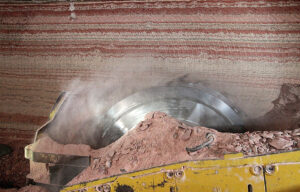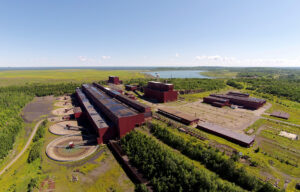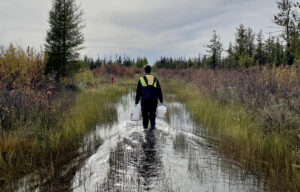Adding lithium to mining operations: Engineering and design factors
 A summer storm rolls in on a lithium mining site in the western U.S.
A summer storm rolls in on a lithium mining site in the western U.S.
The race to develop clean energy and meet carbon neutral goals impacts every facet of energy production. The demand for new electric vehicles (EVs)—and subsequently batteries made with lithium and other critical minerals—continues to skyrocket. In tandem, the COVID-19 pandemic has strained supply chains, forcing the shift to move mining and manufacturing processes back to the United States. As the mining industry adjusts to new consumer expectations, mining for lithium and other critical battery minerals for battery production has risen to the top of the list for evaluation.
At Barr, we have served the mining industry for more than 50 years. Many of our long-term mining clients are now seeking to capitalize on the lithium boom by exploring ways to extract lithium from deposits on their existing sites. This may take the form of existing tailings streams, waste rock piles, end-of-line brines and waste waters, or adjacent deposits onsite or nearby.
When considering adding lithium to your mining portfolio, there are several environmental and engineering areas to focus on in your planning efforts. In this article, we look at three primary engineering and design areas to review. We’ll examine the environmental factors in the second part of this series.
1. Mine planning
-
Consider proper evaluation of the ore body: The acquisition and analysis of ore quality data from investigation programs are critical. This is not only for quantifying the ore body, but also to inform an operational plan that balances costs with revenue at a site. Is there enough data to adequately and statistically define the ore body?
-
Identify operational risks with additional geotechnical information: Extracting additional information, such as geotechnical parameters during exploratory drilling and sampling, helps to identify operational risks. In a best-case scenario, this information can be used to mitigate risk during the planning process. At a minimum, risk can be anticipated and addressed during operations.
-
Consider adopting a lifecycle approach: It is often beneficial to adopt a lifecycle approach. This means thinking through your plans for closure and reclamation at the same time as the planning, construction, and operation of your mining site. By incorporating considerations for closure and reclamation, a lifecycle approach can help you strategically plan your mining operation and avoid unnecessary costs.
2. Existing process
-
Assess your site water balance: Consider your site water balance and the effects that your new circuit could have on existing processes. This could take the form of new reagents making their way into existing processes where they could have unintended effects.
-
Consider a site-wide mass and energy balance: Along the same lines, consider developing a site-wide mass and energy balance that accounts for the interrelations between your existing works and your new circuits. This could take the form of water balance or water quality issues, unexpected bottlenecks in or between circuits, mismatches in up-time between related circuits, or limitations around storage and loadout. On the positive side, it may bring to light some potential process and operational synergies you had not recognized previously.
-
Know your mine process options: Several routes to purified lithium (e.g., chloride, hydroxide, carbonate) are available, including solvent extraction, precipitation, crystallization, and, more recently, direct lithium extraction (DLE). Several companies have developed DLE technologies recently, which take the form of ion exchange, molecular templating, or other similar techniques. The advantages of DLE include potentially lower energy usage, lower water usage, higher selectivity, and flexibility in throughput. There are many tradeoffs in recovering lithium from your resources, and it is important to thoroughly explore your options before selecting a path forward. This includes investing in the front-end test work on representative samples to inform your decisions.
3. Tailings and waste
-
Understand applicable regulations and standards: Which regulations apply to your mining operation? In the U.S., these are often based on the state in which the mine operates. Also, keep in mind the standard to which the facility will be operated, such as the Canadian Dam Association (CDA) or the Global Industry Standard on Tailings Management (GISTM). Understanding these requirements from the beginning will help you plan your tailings and waste storage facility more effectively.
-
Evaluate available tailings technologies: There is no one-size-fits-all tailings technology. Careful consideration should be given to permitting requirements, site-specific constraints, risk tolerance, and cost (both capital and operating). Technologies to consider may include slurry, thickened, or filtered tailings, as well as paste (typically deposited underground as mine backfill).
-
Identify and fill key leadership and technical roles: The GISTM and other leading industry documents require mine owners to identify an accountable executive (AE) and responsible tailings facility engineer (RTFE), both of whom set the tone for the entire operation. An engineer of record (EOR) should also be identified to provide technical expertise, advising the owner as to whether the tailings and waste facility is being designed, constructed, and operated properly.
-
Define the Consequence Classification: The consequence classification can help you make informed decisions regarding operations, level of care, risk mitigation, interactions with the public, stakeholder engagement, and more.
What are the next steps to add lithium to your mining portfolio?
The path to capitalize on the lithium boom can be complicated depending on mine site structure and operations. We’ve outlined some of the key engineering considerations to take into account when planning to extract lithium on your current mine site. The second part of this blog series focuses on the environmental considerations for lithium mining.
For more than five decades, our experienced team of engineers and environmental specialists have partnered with our mining clients to help navigate changing markets, mine expansion, and other operational considerations. If you’re wondering where to start and how to optimize your planning process, contact us to learn more about our mining solutions.
About the authors
Michael Haggerty, vice president, senior geotechnical engineer, has nearly two decades of geotechnical engineering experience on projects involving tunnels, mines, dams, and wind turbines. His work frequently involves the inspection and rehabilitation of existing tunnel infrastructure and the design of underground space.
Dan Palo, vice president, senior process engineer, has 25 years of experience with process design, plant improvement, project management, and research and development for processes that involve minerals, chemicals, fuels, and manufactured products. From research and development through scoping and prefeasibility studies to basic and detailed design, Dan’s work spans the mining life cycle. He routinely helps clients develop both greenfield and brownfield projects from full plant evaluations to the assessment and improvement of existing circuits.
Kurt Schimpke, senior geotechnical engineer, has over 10 years of experience providing tailings management services to mining clients, including alternatives studies, dam design, instrumentation monitoring, dam safety inspections, and third-party reviews. He has been involved in projects across the Midwestern U.S., Canada, and the Middle East.








